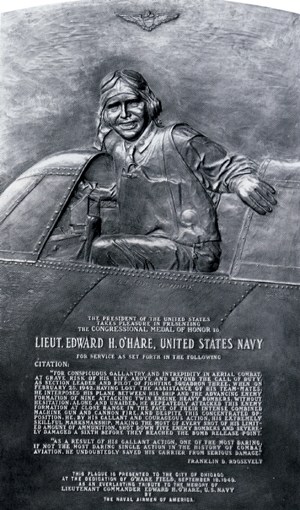
Butch O’Hare’s final act of valor came on the night of November 26, 1943, at Tarawa in the Gilbert Islands. According to the official government account:
When warnings were received of the approach of a large force of enemy torpedo bombers, Lieutenant Commander O’Hare unhesitatingly volunteered to lead the first fighter section of aircraft to take off from a carrier at night and intercept the Japanese attackers. Although limited in the special training necessary for so dangerous an undertaking and fully aware of the hazard involved, he fearlessly led his three-plane group into combat against the largest formation of hostile aircraft and assisted in shooting down two enemy planes and dispersing the remainder.
O’Hare’s plane was hit and went down in the darkness. Frantic efforts to find him proved futile. Almost two years later, on August 14, 1945, the navy finally revealed that O’Hare had been killed in an experiment to determine if fighter planes could be maneuvered into visual contact with enemy planes from a radar-equipped bomber. Something had failed to work.
Condolences poured into St. Louis. Butch O’Hare, twenty-nine years old when he died, left behind a nine-month-old daughter that he probably had never seen. Months later his mother held her first tearful interview with the press. She revealed that during his St. Louis visit in 1942 he had said, “You don’t have time to consider the odds against you. You’re too busy throwing bullets.” She also felt her son’s demise had something to do with the number 13 appearing so frequently in his life, from his birthdate on March 13 to his growing up in St. Louis‘s 13th Ward.
Posthumous honors included the Navy Cross, a new destroyer bearing his name, and a plaque placed in his former dormitory room at the Naval Academy. A shipmate of O’Hare’s described perhaps the most appropriate honor bestowed upon O’Hare in a letter to his mother, Selma. “It seems so fitting that the Navy has named the airfield at Abemama [Gilbert Islands] O’Hare Field.” An airfield is an alive thing and ha the definite hope for the future. . . . He ild be proud of this.”
As the war progressed, many other air aces surpassed Butch O’Hare’s 1942 feat. By January of 1944, eighteen other pilots had shot down six or more enemy planes. Maj. Gregory Boyington and Joe Foss bagged twenty-six planes each. But O’Hare was special. America had been starved heroes. The Great Depression, in which neither intelligence nor physical might nor bravery could stem the tide of hopelessness, had given way to Pearl Harbor. That calamity had shaken the nation’s pride, but the first months of the war saw only sweeping enemy victories at the Philippines, Guam, and Wake Island. In the bleakness of the time, Butch O’Hare was a hero around whom America could rally. Soft-spoken, handsome, and morally proper, he fit the mold of the American war hero, disregarding his personal safety for the sake of his unit and his country.
The most notable honor bestowed on O’Hare came in 1949, six years after his death. The city of Chicago had realized during the war that Municipal Airport at 63rd Street and Cicero Avenue (renamed Midway Airport in 1949 to honor the battle of that name) was increasingly unable to handle the growing volume of air traffic. Landlocked by industry and housing, it had no room to expand. Airport planners also knew that if jet engines, which had appeared late in the war on military planes, were ever adapted to passenger craft, they would require much longer runways than could be built at Municipal.
By 1946 it was clear that the future lay northwest of the city at a complex of buildings and runways where the Douglas Aircraft Company had built C-54s during the war. After a lengthy squabble about how the site, also known as Orchard Field, was to be developed, planners turned to the question of a name.
The Chicago Tribune conducted a sidewalk poll in 1946, and a substantial number of respondents voted to name the airfield after a war hero. O’Hare seemed to be an obvious choice, especially since St. Louisans had decided to keep the name of their airport Lambert Field.

Since the dedication of O’Hare Airport and the unveiling of this memorial plaque on September 18, 1949, the city of Chicago has thought of Buch O;Hare a a native son. Chicago Sun-Times.
Source:
CHICAGO HISTORY
The Magazine of the Chicago Historical Society, Fall and Winter 1988- 89, Volume XVII, Number 3 and 4
YESTERDAY’S CITY BY PERRY R. DUIS
PartI
https://polishnews.com/historia-history/chicago-history/4379-yesterday-s-city-by-perry-r-duis
Part II
https://polishnews.com/historia-history/chicago-history/4381-yesterday-s-city-part-ii
